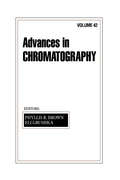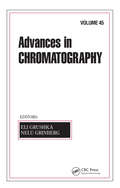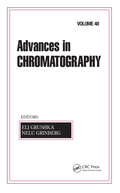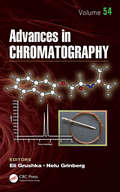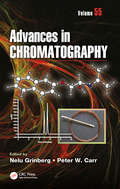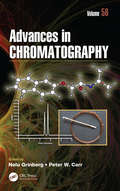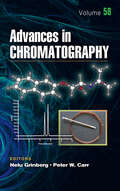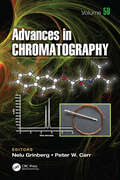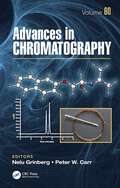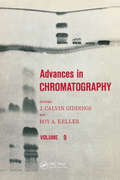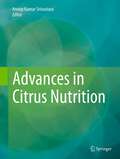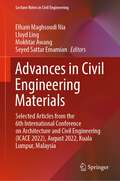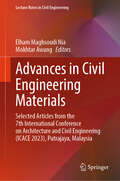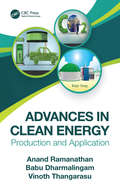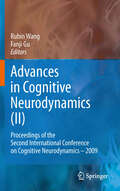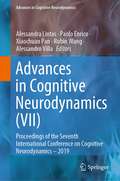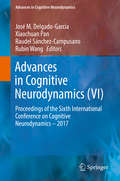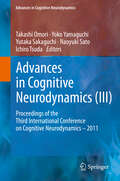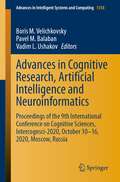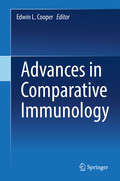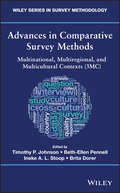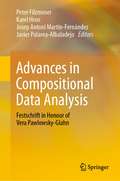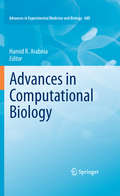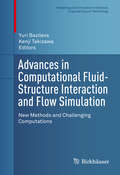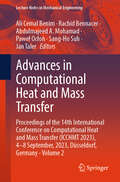- Table View
- List View
Advances in Chromatography: Volume 42 (Advances In Chromatography Ser. #34)
by Eli Grushka Phyllis R. BrownThis book investigates current trends in chemometrics, proteomics, column technology, and element-selective detection for pharmaceutical, medical, industrial, and environmental applications. It offers recent strategies to evaluate and assess materials in air, water, soil, and landfill samples, to determine the amount of hydrocarbons in the atmosphe
Advances in Chromatography: Volume 45 (Advances in Chromatography)
by Nelu Grinberg Eli GrushkaFor more than four decades, scientists and researchers have relied on the Advances in Chromatography series for the most up-to-date information on a wide range of developments in chromatographic methods and applications. Volume 45 of this authoritative series once again compiles the work of expert contributors in order to present timely and cutting
Advances in Chromatography: Volume 48 (Advances in Chromatography)
by Nelu Grinberg Eli GrushkaFor more than four decades, scientists and researchers have relied on the Advances in Chromatography Series for the most up-to-date information on a wide range of developments in chromatographic methods and applications. With contributions from an array of international experts, the latest volume captures new developments in this important field th
Advances in Chromatography: Volume 54 (Advances in Chromatography #54)
by CFor more than five decades, scientists and researchers have relied on the Advances in Chromatography series for the most up-to-date information on a wide range of developments in chromatographic methods and applications. For Volume 54, the series editors have invited established, well-known chemists to offer cutting-edge reviews of chromatographic methods applied in the life sciences that emphasize the underlying principle of separation science. The clear presentation of topics and vivid illustrations for which this series has become known makes the material accessible and engaging to analytical, biochemical, organic, polymer, and pharmaceutical chemists at all levels of technical skill.
Advances in Chromatography: Volume 55 (Advances in Chromatography #55)
by Nelu GrinbergFor more than five decades, scientists and researchers have relied on the Advances in Chromatography series for the most up-to-date information on a wide range of developments in chromatographic methods and applications. For Volume 55, established, well-known chemists offer cutting-edge reviews of chromatographic methods to pay tribute to the late Eli Grushka, beloved series editor, who inspired and mentored many in the field of separation science. The clear presentation of topics and vivid illustrations for which this series has become known makes the material accessible and engaging to analytical, biochemical, organic, polymer, and pharmaceutical chemists at all levels of technical skill.
Advances in Chromatography: Volume 56 (Advances in Chromatography #Vol. 54)
by Nelu Grinberg Peter W. CarrFor more than five decades, scientists and researchers have relied on the Advances in Chromatography series for the most up-todate information on a wide range of developments in chromatographic methods and applications. The clear presentation of topics and vivid illustrations for which this series has become known makes the material accessible and engaging to analytical, biochemical, organic, polymer, and pharmaceutical chemists at all levels of technical skill. Key Features: Includes a chapter dedicated to Izaak Maurits Kolthoff, offering a unique look at his non-professional life as well as his impact and legacy in Analytical Chemistry. Discusses recent advances in two-dimensional liquid chromatography for the characterization of monoclonal antibodies and other therapeutic proteins. Reviews solvation processes, methodologies of their measurement, and parameters influenced solvation Explores recent advances in TLC analysis of natural colorings, determination of synthetic dyes, and determination of EU-permitted natural colors, in foods. Offers comprehensive and critical insights on the key aspects of CE-MS analysis of intact proteins
Advances in Chromatography: Volume 58 (Advances in Chromatography #58)
by Nelu Grinberg and Peter W. CarrFor six decades, scientists and researchers have relied on the Advances in Chromatography series for the most up-to date information on a wide range of developments in chromatographic methods and applications. The clear presentation of topics and vivid illustrations for which this series has become known makes the material accessible and engaging to analytical, biochemical, organic, polymer, and pharmaceutical chemists at all levels of technical skill. Key Features: Discusses the basic concepts of affinity chromatography and examines recent developments in this method and related supramolecular separation methods. Outlines the different types of gradient stationary phases and how they have been used in and benefited the field of separation science. Reviews recent trends in detectors for GC, focusing on those that are readily available and seeing wide usage. Addresses peak compression in GELC and offers the reader a plate height equation to work with that incorporates its effects.
Advances in Chromatography: Volume 59 (Advances in Chromatography #59)
by Nelu Grinberg Peter W. CarrFor six decades, scientists and researchers have relied on the Advances in Chromatography series for the most up-to-date information on a wide range of developments in chromatographic methods and applications. The clear presentation of topics and vivid illustrations for which this series has become known make the material accessible and engaging to analytical, biochemical, organic, polymer, and pharmaceutical chemists at all levels of technical skill. Describes the thermodynamics and kinetics underlying hydrophobic interaction chromatography of proteins. Outlines use of a kinetic model in the predictive modeling of evaporation processes that eliminates the need to know the composition and identity of the chemical constituents in the sample. Explores building and employing QSRR models in cyclodextrin modified high-performance liquid chromatography (HPLC). Reviews chemometric methods commonly paired with comprehensive 2D separations and key instrumental and preprocessing considerations.
Advances in Chromatography: Volume 60 (ISSN)
by Nelu Grinberg Peter W. CarrFor six decades, scientists and researchers have relied on the Advances in Chromatography series for the most up-to-date information on a wide range of developments in chromatographic methods and applications. The clear presentation of topics and vivid illustrations for which this series has become known make the material accessible and engaging to analytical, biochemical, organic, polymer, and pharmaceutical chemists at all levels of technical skill. Presents an in-depth review of chaotropic chromatography. Reviews recent advances in HPLC and SFC columns packed with hybrid organic/inorganic particles. Explores new advances in nano-liquid chromatography for proteomics analysis. Outlines the heterogeneity of gangliosides and advances in the chromatographic techniques used in their separation.
Advances in Chromatography: Volume 9 (Advances In Chromatography Ser. #14)
by J. Calvin GiddingsThis book provides up-to-date information on a wide range of developments in the general and gas chromatographic methods and applications. It presents timely, cutting-edge reviews in the fields of bio-, analytical, organic, polymer, and pharmaceutical chemistry.
Advances in Citrus Nutrition
by Anoop Kumar SrivastavaThis is a solitary attempt to streamline all the possible information related to citrus nutrition, with emphasis on diagnosis and management of nutrient constraints, employing a variety of state-of-art techniques evolved globally over the years . While doing so care has been taken to include peripheral disciplines so that the discussion becomes more lively and authoritative. An entire array of exclusive subjects has been nicely portrayed with the help of latest data and photographs.
Advances in Civil Engineering Materials: Selected Articles from the 6th International Conference on Architecture and Civil Engineering (ICACE 2022), August 2022, Kuala Lumpur, Malaysia (Lecture Notes in Civil Engineering #310)
by Mokhtar Awang Seyed Sattar Emamian Lloyd Ling Elham Maghsoudi NiaThis book presents selected articles from the 6th International Conference on Architecture and Civil Engineering 2022 (ICACE 2022), held in Malaysia. Written by leading researchers and industry professionals, the papers highlight recent advances and addresses current issues in the fields of civil engineering and architecture.
Advances in Civil Engineering Materials: Selected Articles from the 7th International Conference on Architecture and Civil Engineering (ICACE 2023), Putrajaya, Malaysia (Lecture Notes in Civil Engineering #466)
by Mokhtar Awang Elham Maghsoudi NiaThis book showcases the latest research in civil engineering and architectural materials, with a specific focus on the following key areas: circularity, energy retrofitting, building materials, structural advancements, and transportation innovations. The research findings and advancements presented in this book are a part of the 7th International Conference on Architecture and Civil Engineering (ICACE 2023), held on 15 November 2023 at the Everly Hotel Putrajaya, Malaysia. This conference serves as a prominent platform for researchers, professionals, and industry experts to exchange knowledge and ideas in order to advance the fields of civil engineering and architecture.
Advances in Clean Energy: Production and Application
by Anand Ramanathan Babu Dharmalingam Vinoth ThangarasuAdvances in Clean Energy: Production and Application supports sustainable clean energy technology and green fuel for clean combustion by reviewing the pros and cons of currently available technologies specifically for biodiesel production from biomass sources, recent fuel modification strategy, low-temperature combustion technology, including other biofuels as well. Written for researchers, graduate students, and professionals in mechanical engineering, chemical engineering, energy, and environmental engineering, this book: Covers global energy scenarios and future energy demands pertaining to clean energy technologies Provides systematic and detailed coverage of the processes and technologies used for biofuel production Includes new technologies and perspectives, giving up-to-date and state-of-the-art information on research and commercialization Discusses all conversion methods including biochemical and thermochemical Examines the environmental consequences of biomass-based biofuel use
Advances in Cognitive Neurodynamics: Proceedings of the Second International Conference on Cognitive Neurodynamics - 2009 (Advances in Cognitive Neurodynamics)
by Fanji Gu Rubin WangWithin our knowledge, the series of the International Conference on Cognitive Neurodynamics (ICCN) is the only conference series dedicating to cognitive neurodynamics. This volume is the proceedings of the 2nd International Conference on Cognitive Neurodynamics held in 2009, which reviews the progress in this field since the 1st ICCN -2007. The topics include: Neural coding and realistic neural network dynamics, Neural population dynamics, Firing Oscillations and Patterns in Neuronal Networks, Brain imaging, EEG, MEG, Sensory and Motor Dynamics, Global cognitive function, Multi-scalar Neurodynamics - from Physiology to Systems Theory, Neural computing, Emerging Technologies for Brain Computer Interfaces, Neural dynamics of brain disorders.
Advances in Cognitive Neurodynamics: Proceedings of the Seventh International Conference on Cognitive Neurodynamics – 2019 (Advances in Cognitive Neurodynamics)
by Rubin Wang Xiaochuan Pan Alessandra Lintas Paolo Enrico Alessandro VillaThis book contains original articles submitted to the Seventh International Conference on Cognitive Neurodynamics (ICCN 2019). The brain is an endless case study of a complex system characterized by multiple levels of integration, multiple time scales of activity, and multiple coding and decoding properties. The contribution of several disciplines, mathematics, physics, computer science, neurobiology, pharmacology, physiology, and behavioral and clinical sciences, is necessary in order to cope with such seemingly unattainable complexity that transforms the experimental information into a tricky puzzle which hides the correspondence with model predictions. This conference gathered active participants to discuss ideas and pose new questions from different viewpoints, ranging from single neurons and neural networks to animal/human behavior in theoretical and experimental studies. The conference is organized with plenary lectures, mini-symposia, interdisciplinary round tables, and oral and poster sessions.
Advances in Cognitive Neurodynamics: Proceedings of the Sixth International Conference on Cognitive Neurodynamics – 2017 (Advances in Cognitive Neurodynamics)
by Rubin Wang Xiaochuan Pan José M. Delgado-García Raudel Sánchez-CampusanoThis proceedings contains articles submitted to the sixth International Conference on Cognitive Neurodynamics (ICCN2017). The Meeting included plenary lectures, specialized symposia, and posters presentations. The main topics of the meeting addressed the general substrates underlying neural functions and the neural dynamics in sensory, motor, and cognitive systems. Other important neuroscience fields covered in the meeting were learning and memory processes and the functionally-related changes in synaptic strength, neural oscillations, synchronizations and coherence activities between different neural circuits, and the imaging of cognitive networks. Finally, specific articles covered several fields related to neural computation and neuroengineering, the modelling higher-order functions and dysfunctions and the experimental design of brain-to-computer and brain-to-brain interactions. All articles were peer-reviewed. The ICCN is a series conference that takes place every two years since 2007.
Advances in Cognitive Neurodynamics: Proceedings of the Third International Conference on Cognitive Neurodynamics - 2011 (Advances in Cognitive Neurodynamics)
by Yoko YamaguchiWithin our knowledge, the series of the International Conference on Cognitive Neurodynamics (ICCN) is the only conference series dedicating to cognitive neurodynamis. This volume is the proceedings of the 3rd International Conference on Cognitive Neurodynamics held in 2011, which reviews the progress in this field since the 1st ICCN - 2007. The topics include: Neural coding and realistic neural network dynamics, Neural population dynamics, Firing Oscillations and Patterns in Neuronal Networks, Brain imaging, EEG, MEG, Sensory and Motor Dynamics, Global cognitive function, Multi-scalar Neurodynamics - from Physiology to Systems Theory, Neural computing, Emerging Technologies for Brain Computer Interfaces, Neural dynamics of brain disorders.
Advances in Cognitive Research, Artificial Intelligence and Neuroinformatics: Proceedings of the 9th International Conference on Cognitive Sciences, Intercognsci-2020, October 10-16, 2020, Moscow, Russia (Advances in Intelligent Systems and Computing #1358)
by Boris M. Velichkovsky Pavel M. Balaban Vadim L. UshakovThis book reports on theoretical and experimental research answering key questions in neuroscience, philosophy of mind, and cognitive research. It gives a special emphasis on findings achieved within the territory of the former U.S.S.R, which has remained largely unknown to an international readership. The volume gathers authoritative studies on cognitive development, consciousness, attention and perception. It covers research on eye movements, language, speech and semantics, emotion, as well as brain functional states, and a variety of decision-making processes. It also highlights important advances in cognitive robotics and artificial intelligence, discussing brain-computer interfaces and other practically-relevant technologies. It includes studies on human subjects, in both healthy and disease conditions, and investigations on the molecular mechanisms of cognition in animal models.Chapters are based on invited lectures and peer-reviewed contributions to the 9th International Conference on Cognitive Sciences, Intercognsci–2020, held on October 10-16, 2020, in Moscow. The conference was organized by the Interregional Association of Cognitive Studies, with the participation of the Pavlov Society for Neurophysiology and Higher Nervous Activity, and supported by the Russian Academy of Sciences, the Russian Foundation for Basic Research and a number of the north eastern European research institutions. All in all, this book provides cognitive scientists around the world with a timely snapshot of interdisciplinary research and cutting-edge models, and a major source of inspiration for future collaborations in the areas of artificial intelligence and cognitive neuroscience.
Advances in Comparative Immunology
by Edwin L. CooperImmunologists, perhaps understandably, most often concentrate on the human immune system, an anthropocentric focus that has resulted in a dearth of information about the immune function of all other species within the animal kingdom. However, knowledge of animal immune function could help not only to better understand human immunology, but perhaps more importantly, it could help to treat and avoid the blights that affect animals, which consequently affect humans. Take for example the mass death of honeybees in recent years – their demise, resulting in much less pollination, poses a serious threat to numerous crops, and thus the food supply. There is a similar disappearance of frogs internationally, signaling ecological problems, among them fungal infections. This book aims to fill this void by describing and discussing what is known about non-human immunology. It covers various major animal phyla, its chapters organized in a progression from the simplest unicellular organisms to the most complex vertebrates, mammals. Chapters are written by experts, covering the latest findings and new research being conducted about each phylum. Edwin L. Cooper is a Distinguished Professor in the Laboratory of Comparative Immunology, Department of Neurobiology at UCLA’s David Geffen School of Medicine.
Advances in Comparative Survey Methods: Multinational, Multiregional, and Multicultural Contexts (3MC) (Wiley Series in Survey Methodology)
by Timothy P. Johnson Beth-Ellen Pennell Ineke A. Stoop Brita DorerCovers the latest methodologies and research on international comparative surveys with contributions from noted experts in the field Advances in Comparative Survey Methodology examines the most recent advances in methodology and operations as well as the technical developments in international survey research. With contributions from a panel of international experts, the text includes information on the use of Big Data in concert with survey data, collecting biomarkers, the human subject regulatory environment, innovations in data collection methodology and sampling techniques, use of paradata across the survey lifecycle, metadata standards for dissemination, and new analytical techniques. This important resource: Contains contributions from key experts in their respective fields of study from around the globe Highlights innovative approaches in resource poor settings, and innovative approaches to combining survey and other data Includes material that is organized within the total survey error framework Presents extensive and up-to-date references throughout the book Written for students and academic survey researchers and market researchers engaged in comparative projects, this text represents a unique collaboration that features the latest methodologies and research on global comparative surveys.
Advances in Compositional Data Analysis: Festschrift in Honour of Vera Pawlowsky-Glahn
by Peter Filzmoser Josep Antoni Martín-Fernández Karel Hron Javier Palarea-AlbaladejoThis book presents modern methods and real-world applications of compositional data analysis. It covers a wide variety of topics, ranging from an updated presentation of basic concepts and ideas in compositional data analysis to recent advances in the context of complex data structures. Further, it illustrates real-world applications in numerous scientific disciplines and includes references to the latest software solutions available for compositional data analysis, thus providing a valuable and up-to-date guide for researchers and practitioners working with compositional data. Featuring selected contributions by leading experts in the field, the book is dedicated to Vera Pawlowsky-Glahn on the occasion of her 70th birthday.
Advances in Computational Biology (Advances in Experimental Medicine and Biology #680)
by Hamid R. ArabniaProceedings of The 2009 International Conference on Bioinformatics and Computational Biology in Las Vegas, NV, July 13-16, 2009. Recent advances in Computational Biology are covered through a variety of topics. Both inward research (core areas of computational biology and computer science) and outward research (multi-disciplinary, Inter-disciplinary, and applications) will be covered during the conferences. These include: Gene regulation, Gene expression databases, Gene pattern discovery and identification, Genetic network modeling and inference, Gene expression analysis, RNA and DNA structure and sequencing, Biomedical engineering, Microarrays, Molecular sequence and structure databases, Molecular dynamics and simulation, Molecular sequence classification, alignment and assembly, Image processing In medicine and biological sciences, Sequence analysis and alignment, Informatics and Statistics in Biopharmaceutical Research, Software tools for computational biology and bioinformatics, Comparative genomics; and more.
Advances in Computational Fluid-Structure Interaction and Flow Simulation: New Methods and Challenging Computations (Modeling and Simulation in Science, Engineering and Technology)
by Yuri Bazilevs Kenji TakizawaThis contributed volume celebrates the work of Tayfun E. Tezduyar on the occasion of his 60th birthday. The articles it contains were born out of the Advances in Computational Fluid-Structure Interaction and Flow Simulation (AFSI 2014) conference, also dedicated to Prof. Tezduyar and held at Waseda University in Tokyo, Japan on March 19-21, 2014. The contributing authors represent a group of international experts in the field who discuss recent trends and new directions in computational fluid dynamics (CFD) and fluid-structure interaction (FSI). Organized into seven distinct parts arranged by thematic topics, the papers included cover basic methods and applications of CFD, flows with moving boundaries and interfaces, phase-field modeling, computer science and high-performance computing (HPC) aspects of flow simulation, mathematical methods, biomedical applications, and FSI. Researchers, practitioners, and advanced graduate students working on CFD, FSI, and related topics will find this collection to be a definitive and valuable resource.
Advances in Computational Heat and Mass Transfer: Proceedings of the 14th International Conference on Computational Heat and Mass Transfer (ICCHMT 2023), 4-8 September, 2023, Düsseldorf, Germany - Volume 2 (Lecture Notes in Mechanical Engineering)
by Jan Taler Paweł Ocłoń Ali Cemal Benim Rachid Bennacer Abdulmajeed A. Mohamad Sang-Ho SuhThis book reports on cutting-edge applied research and methods in the area of heat and mass transfer and computational fluid dynamics. With a special emphasis on computational methods, it covers applications to different fields, including mechanical engineering, aerospace, and energy, among others. Some relevant experimental validations are described as well. Being the second volume of the two-volume proceedings of the 14th International Conference on Computational Heat and Mass Transfer, ICCHMT 2023, held on September 4-8, 2023, in Düsseldorf, Germany, this book offers a timely perspective of research and applications in the field of computational heat and mass transfer. It also provides both academics and professionals with extensive information and a source of inspiration for new developments and collaborations.
